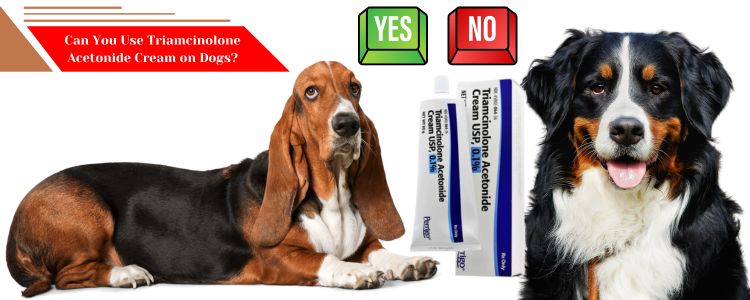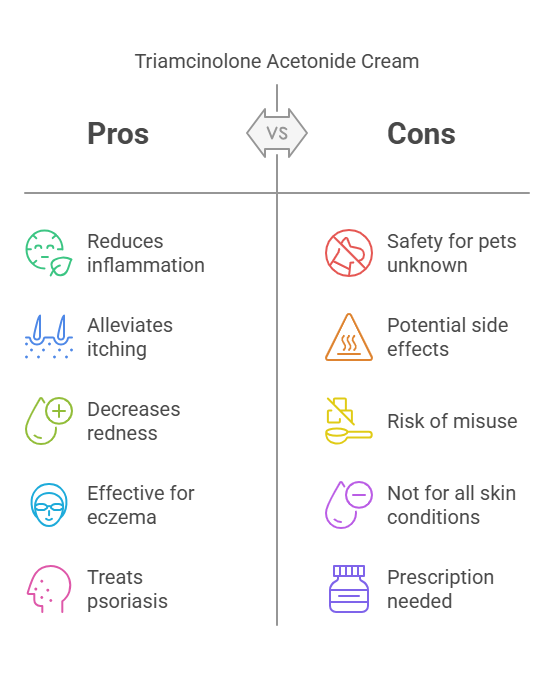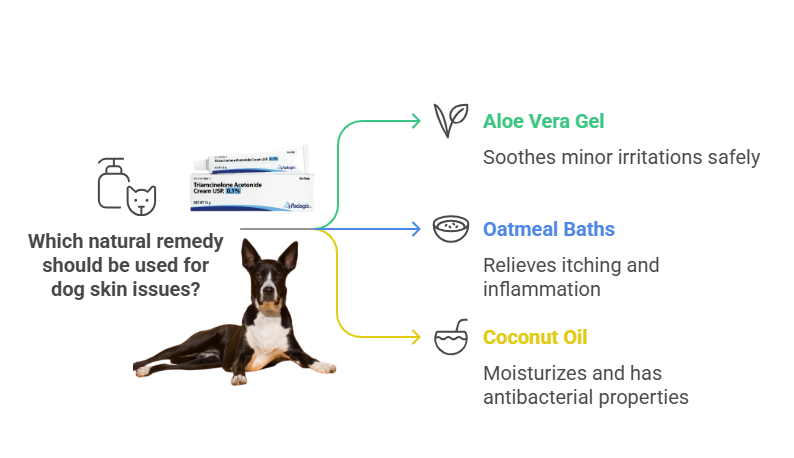Yes, Triamcinolone Acetonide Cream can be used on dogs, but only under the guidance of a veterinarian. This corticosteroid cream is often prescribed to treat skin conditions like allergic dermatitis, eczema, or inflammation in dogs. However, it must be used cautiously, as improper application can lead to side effects such as skin thinning, increased risk of infections, or hormonal imbalances
According to a study published in the Journal of Veterinary Medicine,
Topical corticosteroids like triamcinolone are effective in managing mild skin conditions in dogs when used under supervision. The study also highlights the importance of precise dosage to prevent side effects.
Understanding Triamcinolone Acetonide Cream
Triamcinolone acetonide cream is a topical corticosteroid commonly used to reduce inflammation, itching, and redness in humans. It’s effective for treating skin conditions like eczema, psoriasis, and dermatitis. But is it safe for your furry companion?
Many dog owners encounter skin issues like hot spots, rashes, or allergies in their pets. Knowing whether this cream can be used safely on dogs is crucial for their health and comfort. Let’s explore its benefits, risks, and safe application methods.
Is Triamcinolone Acetonide Cream Safe for Dogs?
The short answer: It depends. Triamcinolone acetonide cream can be used on dogs but only under veterinary guidance. This medication is potent and must be used carefully to avoid adverse effects.
Dogs’ skin is different from humans’, and using human medications on pets without proper consultation can lead to complications. Always consult your veterinarian before applying any cream or ointment to your dog’s skin.
The American Veterinary Medical Association (AVMA)
Emphasizes consulting a vet before using human medications on pets. Misuse can lead to unintended health issues.
How Does It Work on Dogs?
Triamcinolone acetonide cream effectively reduces inflammation by targeting substances in the body that trigger swelling, redness, and itching. These reactions often cause discomfort for dogs, and this cream helps alleviate those symptoms. By calming the inflammation, it allows the skin to heal properly.
Veterinarians may prescribe triamcinolone acetonide cream for several conditions, including:
- Allergic Dermatitis: Often caused by environmental allergens, food sensitivities, or insect bites, this condition results in itchy, inflamed skin.
- Hot Spots (Acute Moist Dermatitis): These are red, moist, and irritated patches caused by excessive licking, chewing, or scratching.
- Bug Bites or Stings: Insect bites can cause localized irritation that benefits from anti-inflammatory treatment.
- Localized Skin Irritation: Minor irritations from contact with allergens or irritants can be soothed by this cream.
Its targeted action ensures that affected areas get relief while minimizing exposure to the rest of the body.
Proper Application for Dogs
When your veterinarian prescribes triamcinolone acetonide cream, follow these steps for safe application:
- Clean the Affected Area: Gently clean the area with mild soap and water. Pat it dry with a soft cloth.
- Apply a Thin Layer: Use a small amount of cream. Spread it evenly over the affected area.
- Prevent Licking: Dogs tend to lick anything applied to their skin. Use an Elizabethan collar (e-collar) to stop them from ingesting the cream.
- Follow the Dosage: Apply the cream exactly as directed. Overuse can lead to skin thinning or systemic absorption.
Side Effects in Dogs
Using triamcinolone acetonide cream on dogs can cause side effects if not used correctly. Common side effects include:
- Skin Thinning: Overuse can lead to the skin becoming fragile and more prone to injury.
- Increased Sensitivity to Infections: The cream may suppress the immune response, making infections more likely.
- Delayed Wound Healing: Corticosteroids can slow down the body’s natural ability to repair damaged tissue.
- Hormonal Imbalances: Prolonged use can disrupt your dog’s hormonal balance, potentially causing systemic effects.
Severe side effects are rare but can include:
- Excessive Thirst (Polydipsia): A sign of systemic absorption affecting the adrenal glands.
- Increased Urination (Polyuria): Often linked to changes in hormone regulation.
- Lethargy: Indicates that the medication might be affecting your dog’s overall system.
Contact your vet immediately if you notice any of these severe symptoms. They may adjust the dosage or recommend alternative treatments.
Natural Alternatives for Dog Skin Issues
If you prefer to avoid medications, several natural remedies can help soothe your dog’s skin:
- Aloe Vera Gel: Natural aloe vera is safe and soothing for minor irritations.
- Oatmeal Baths: Colloidal oatmeal can relieve itching and inflammation.
- Coconut Oil: Known for its antibacterial properties, it helps moisturize dry, irritated skin.
Always test a small amount of any natural remedy on your dog’s skin to ensure there’s no allergic reaction.
Tips for Preventing Skin Problems in Dogs
Prevention is always better than treatment. Follow these tips to keep your dog’s skin healthy:
- Regular Grooming: Brush your dog’s coat regularly to remove dirt, debris, and loose fur. This helps prevent matting and stimulates natural oil production for healthier skin.
- Balanced Diet: Feed your pet high-quality food rich in essential fatty acids, vitamins, and minerals. Nutrients like omega-3 fatty acids can significantly improve skin and coat health.
- Flea Control: Use veterinarian-approved flea and tick preventatives to protect your dog from pests that can cause itching, irritation, or infections.
- Hydration: Ensure your dog has access to clean, fresh water at all times. Proper hydration maintains skin elasticity and prevents dryness.
- Regular Check-Ups: Schedule routine visits to the vet to monitor your dog’s overall health and catch any skin issues early before they worsen.
- Safe Bathing Practices: Use pet-friendly shampoos and avoid overbathing, which can strip natural oils from the skin.
- Environment Monitoring: Keep your dog’s living area clean and free from allergens like dust or mold, which can trigger skin reactions.
FAQs About Triamcinolone Acetonide Cream and Dogs
1. Can I use over-the-counter triamcinolone cream on my dog? No. Always consult your vet before using any over-the-counter medication on your pet. Some creams may contain ingredients harmful to dogs.
2. How often should I apply triamcinolone cream to my dog’s skin? Follow your vet’s instructions. Typically, it’s applied 1-2 times daily for a few days.
3. What should I do if my dog licks the cream? If your dog ingests the cream, contact your vet immediately. They may recommend monitoring for side effects or other interventions.
4. Are there safer alternatives to triamcinolone for dogs? Yes. Depending on the condition, your vet may suggest milder options or natural remedies.
5. Can this cream treat severe skin conditions in dogs? It’s effective for mild to moderate issues. Severe conditions may require systemic treatments or stronger medications prescribed by your vet.
Final Thoughts
Triamcinolone acetonide cream can be a helpful tool for treating certain skin issues in dogs. However, it should never be used without veterinary approval. Always prioritize your pet’s safety by consulting a professional and following prescribed treatments carefully. Taking these precautions ensures your dog stays healthy, happy, and free from skin discomfort.



